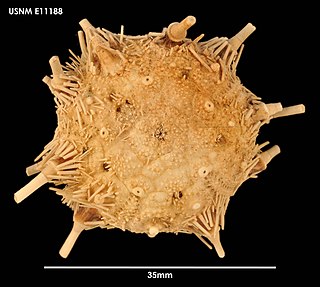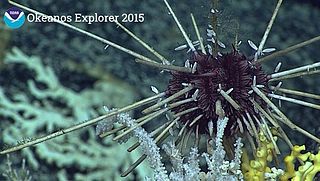
The Diadematidae are a family of sea urchins. Their tests are either rigid or flexible and their spines are long and hollow.

Cidaris is a genus of pencil sea urchins.

Coelopleurus is an extant genus of echinoids with fossil records dating back to the Eocene, with remains found in Europe and North America.

Cidaridae is a family of sea urchins in the order Cidaroida.

Spatangus is a genus of heart urchins in the Spatangidae family. The genus is synonymous with the previously recognised genera Prospatangus Lambert, 1902 and Spatagus. There are nine recognised species. The type species is Spatangus purpureus Müller, 1776 by subsequent designation.
Amphipneustes tumescens is a species of sea urchin of the family Temnopleuridae. Their armour is covered with spines. It is placed in the genus Amphipneustes and lives in the sea. Amphipneustes tumescens was first scientifically described in 1926 by Koehler.
Anabrissus damesi is a species of sea urchin of the family Brissidae. Their armour is covered with spines. It is placed in the genus Anabrissus and lives in the sea. Anabrissus damesi was first scientifically described in 1881 by Alexander Agassiz, American scientist and engineer.

Holasteroida is an order of irregular sea urchins.

Clypeaster, common name "cake urchins" or "sea biscuits", is a genus of echinoderms belonging to the family Clypeasteridae.
Ceratophysa ceratopyga is a species of sea urchins of the family Pourtalesiidae. Their armour is covered with spines. Ceratophysa ceratopyga was first scientifically described in 1879 by Alexander Emanuel Agassiz.
Ceratophysa rosea is a species of sea urchins of the family Pourtalesiidae. Their armour is covered with spines. Ceratophysa rosea was first scientifically described in 1879 by Alexander Emanuel Agassiz.

The Echinothuriidae are a family of sea urchins in the order Echinothurioida. Due to their soft skeletons, most are called "leather urchins", but species in the genus Asthenosoma are also known as "fire urchins" due to their bright colors and painful, venomous sting.

Araeosoma is a genus of deep-sea sea urchins in the family Echinothuriidae.

Aporocidaris is a genus of sea urchins in the family Ctenocidaridae. Several species are found in deep water in circum-Antarctic locations.

Histocidaris is a genus of sea urchins in the family Histocidaridae. Some species are known from the fossil record.

Pourtalesia is a genus of the family Pourtalesiidae which belongs to the irregular sea urchins. The animals measure 5–6 cm in length and live in the abyssal zone of the Atlantic, Pacific, Indopacific and Antarctic Oceans where they have been found in more than 3,000 m depth. The mouth opening of these animals is located anteriorly and the lantern of Aristotle is missing as typically for holasteroid sea urchins.

Caenopedina is a genus of sea urchins of the family Pedinidae.

Aspidodiadema is a genus of echinoderms belonging to the family Aspidodiadematidae. The species of this genus are found in the Indo-Pacific and Caribbean.
Austrocidaris is a genus of sea urchins belonging to the family Cidaridae.
Brissopsis is a genus of echinoderms belonging to the family Brissidae.












